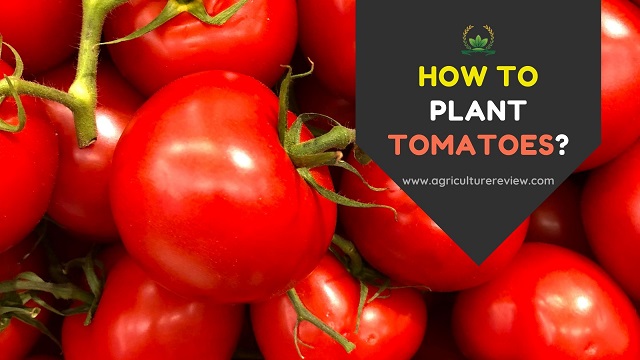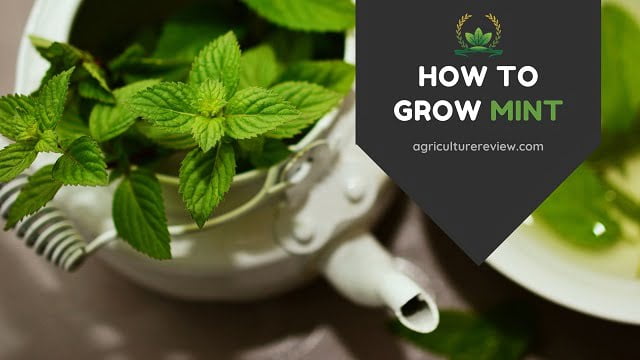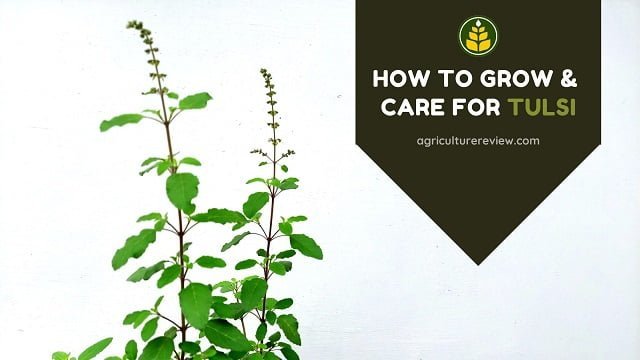If you are interested to learn on how to plant tomatoes then you are on the right page. In this article Agriculture Review will guide you to plant and grow tasty and nutritive tomatoes in your home garden. I have discussed both organic and inorganic ways to plant and grow tomato plants in this article.
 |
| How to plant tomatoes? |
Tomatoes are great source of vitamin C, vitamin K, Potassium, and Folate. In per 100 grams of tomato fruit there are around 3.9 grams of carbohydrates, 2.6 grams of sugar, 1.2 grams of fibres, and 0.9 grams of protein.
So when you are growing or planting a tomato plant in your garden then you are not just growing any plant but you are adding value to your kitchen and food by growing such a useful fruiting plant in your own garden.
But hey wait, are you confused on how to plant tomatoes, or you have tried multiple time growing or planting tomatoes in your garden but didn’t get the expected result, then don’t worry, Agriculture Review is right here for you.
After reading this article you will be able to know why you face failures while growing tomato, and what you should do to convert your experience of growing tomatoes into a success.
Every plant requires or is affected by many factors for the growth and development, if you know to take care of these factors very well then you can become a successful grower. Read this article very carefully to know those important points.
Table of Contents
How to plant tomatoes?
Planting and growing tomatoes is not a very hard job if you knowns about the growing season, selection of varieties, selection of pot, propagation methods, transplantation, sunlight, irrigation, fertilizer, pest and disease management and harvesting time and method.
Tomato can be annual as well as short lived perennials depending on the cultivar or variety, it is a plant that can not with stand frost, which means in temperature below 16 degree celsius tomato plant will not be able to grow properly.
Growing Season
Tomato can be grown both in tropical and in temperate regions. Although the sowing time differs, in temperate regions or hilly areas it can be grown as a summer fruit vegetable during the spring season from seeds.
In tropical and subtropical regions, sowing of the seeds of tomato should be done in June to July, October to November, and January to February. The optimum temperature range for the ideal growth of tomato plant is from 16 to 27 degree Celcius.
Selection of Variety
Selecting a good variety is a very important step for planting and growing tomato. Always purchase disease resistant, high yielding, dwarf variety of tomato plant seeds from the nearest plant nursery.
If you have large space and you are very passionate about gardening then you can also go for high yielding tall varieties of tomato plants.
Pusa Ruby, Roma, Arka Sourabh, Arka Vikas, Arka Meghali, Arka Aahuthi, Arka Ashish, NTDR-1 are some improved tomato varieties in India, you can easily find the names of improved tomato varieties that is suitable for your region on google.
Potting Mix
To grow a plant successfully, preparation of ideal potting mix is necessary. To grow your tomato plant successfully, prepare potting mix with 40% soil + 20% river sand + 40% any organic compost like vermicompost.
If you have sandy loam soil then you do not need to add sand in your potting mix. But if your garden soil is heavy, clayey, and have waterlogging problems then add river sand. Mix the ingredients of the potting mix properly.
Selection of Pot
Tomatoes can be grown in medium to larges sized earthen, cemented or plastic pots with at least three to four drainage holes at the bottom. Drainage holes helps to remove excess water from the pot.
I personally do not prefer very small pots for growing tomatoes. If you are growing directly in the ground soil then at least 2 feet distance should be there between each plant.
Propagation
Tomato plant can be propagated very easily from seeds, purchase high quality, disease resistant, high yielding variety seeds from the plant nursery in your region. Make sure about the sowing time and suitable climate to grow the selected variety seeds.
If you have scarcity of time and patience then you can directly purchase healthy seedlings from the plant nursery and then transplant it your garden. For that you can skip the propagation step and read directly from the transplantation.
You can plant tomatoes through direct sowing method or you can raise the seedlings in germination tray and then transplant them in growing pots. I will suggest you to plant tomatoes from direct sowing method.
In direct sowing method for germinating tomato plants from seeds, fill the growing pot of suitable size with potting mix and leave one to two inch space at the top for watering. Broadcast the purchased seeds on the soil in the pot and cover it with half inch layer of potting mix.
Keep the growing pot in semi shade region where it can receive filtered sunlight. Water your pot gently to moist the soil without disturbing seeds, do not overwater, keep in mind that overwatering can harm seeds.
Water your pot only when the top layer of the soil in the pot seems drying. For better performance and success, sterilize the soil used in the potting mix by sun drying for one week. This will kill all the harmful bacteria present in the soil.
You can also spray Epsom salt solution or potassium rich fertilizer in water only once after sowing the seeds. This will promote better seedling growth and germination.
Within 10 days you will notice, new seedling coming out of the soil, when they reach a height of 2 inch then it is the time for thinning. Select the weak and diseased plant and remove them carefully. By this time you can place the pot under direct sun, if the temperature is less than 27 degree celcius.
Transplantation
Once your tomato seedlings have reached 4 to 5 leaved stage then you can start transplanting. Fill the growing pots with potting mix + one handful neem cake fertilizer + one spoon bone meal mixed thoroughly and leave one to two inch space at the top. Make sure that drainage holes at the bottom remains functional.
With the help of gardening tool like trovel take out seedlings from the main pot along with roots and soil attached to it, make sure that the root and plant parts do not get damaged while transplanting.
Dig a hole in the centre of the pot that is suitable to hold roots, and place one plant in each growing pot, if the pot is very large then you can plant at 2 feet distance, cover the base with potting mix and press around very gently to fix the plant in the soil.
Apply water in the pot gently and leave the pot in semi shade for ten days. It will help the plant to get established in the new pot. Keep watering whenever you notice that the upper layer of soil is dry.
Tomato Plant Care
Whether you are already growing tomato plants in your home garden or you are going to start growing them in your garden these important points on tomato plant care is definitely going to help you to grow tomato.
Your tomato plant will need support to grow properly, provide support with the help of long stakes or sticks by inserting them in the soil and tie plants carefully to the stakes with the help of rope.
Sunlight
Tomato plants loves sunlight to grow, place your pot in the region where the plant can receive at least six to eight hours of direct sunlight, however if the temperature is above 27 degrees celcius then move your pot in semi shade region.
Sunlight helps in vegetative growth of the plant and hence is a very important requirement for growing plants.
Watering
Watering is the next important step that you need to care about. Most beginners do this common mistake of overwatering and underwatering, both conditions are harmful for plants and can even kill your plants.
Watering should be done only when the top layer of the soil seems dry. Any deformation in the plant doesn’t mean that it requires water. Watering should be such that only a little water comes out of the pot.
There should not be waterlogging conditions in the pot as it can give rise to fungal diseases. You can apply water in early mornings and evenings as per the requirement of the plant. Tomato loves moist but not soggy soil.
Fertilizer
Once your plant has well established after transplantation then you can start feeding your plants. If you are growing in inorganic way then you can start adding 1/2 teaspoon of NPK in the ratio 10:10:10 during the early growth days along with a pinch of micronutrients once in a month.
During flowering stage of the plant start feeding with 1/2 teaspoon NPK in the ratio 5:10:10 with a pinch of micronutrients, once in a month.
If you are growing in organic way then you can add two to three handful of vermicompost or any organic manure once in a month, along with this you can add one spoon bone meal after every 30 days.
Nowadays people have started using waste decomposer in their garden to grow plants organically, if you want to know about waste decomposer then visit the link given below.
READ MORE: WASTE DECOMPOSER: BIO FERTILIZER AND BIO PESTICIDE
Pest and Disease
Tomato plant can get disturbed by aphids, flea beetles, tomato hornworm, white flies, etc. Common tomato diseases are Late blight, leaf curl of tomato, damping off, fusarium wilt, etc. To know more about disease and control of tomato plants visit the link given below.
READ MORE: DISEASE AND CONTROL OF TOMATO PLANT
If you want to control leaf curl of tomato and white flies then visit the link given below.
READ MORE: HOW TO CONTROL LEAF CURL OF TOMATO
Keep removing weeds from the pot or the ground time to time to minimize the risk of pest and disease attack on the plant. Weeds can harbour pest and disease. To save your plant from any pest attack, keep spraying neem oil spray once after every two weeks.
READ MORE: HOW TO PREPARE AND USE NEEM OIL SPRAY
Harvesting
After around 90 to 120 days of transplantation, tomato fruits will become ready to be harvested. Look for firm, red coloured tomato fruits and keep harvesting them according to your need with the help of cutting scissors.
You can now enjoy the delicious taste of tomatoes grown in your home garden, if they are harvested in excess then store them in refrigerator for further use.
If you still have any query on how to plant tomatoes then you can contact me on my Facebook as well as on Instagram page Agriculture Review.


